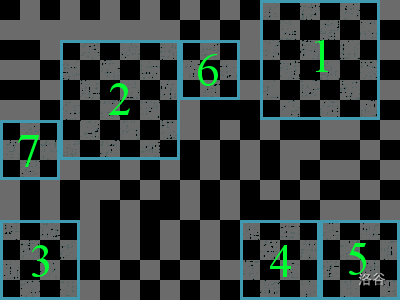#P13398. [GCJ 2010 #1C] Making Chess Boards
[GCJ 2010 #1C] Making Chess Boards
题目描述
The chess board industry has fallen on hard times and needs your help. It is a little-known fact that chess boards are made from the bark of the extremely rare Croatian Chess Board tree, (Biggus Mobydiccus). The bark of that tree is stripped and unwrapped into a huge rectangular sheet of chess board material. The rectangle is a grid of black and white squares.
Your task is to make as many large square chess boards as possible. A chess board is a piece of the bark that is a square, with sides parallel to the sides of the bark rectangle, with cells colored in the pattern of a chess board (no two cells of the same color can share an edge).
Each time you cut out a chess board, you must choose the largest possible chess board left in the sheet. If there are several such boards, pick the topmost one. If there is still a tie, pick the leftmost one. Continue cutting out chess boards until there is no bark left. You may need to go as far as cutting out 1-by-1 mini chess boards.
Here is an example showing the bark of a Chess Board tree and the first few chess boards that will be cut out of it.

输入格式
The first line of the input gives the number of test cases, . test cases follow. Each one starts with a line containing the dimensions of the bark grid, and . will always be a multiple of . The next lines will each contain an -character hexadecimal integer, representing a row of the bark grid. The binary representation of these integers will give you a strings of bits, one for each row. Zeros represent black squares; ones represent white squares of the grid. The rows are given in the input from top to bottom. In each row, the most-significant bit of the hexadecimal integer corresponds to the leftmost cell in that row.
输出格式
For each test case, output one line containing "Case #: ", where is the case number (starting from ) and is the number of different chess board sizes that you can cut out by following the procedure described above. The next lines should contain two integers each -- the size of the chess board (from largest to smallest) and the number of chess boards of that size that you can cut out.
4
15 20
55555
FFAAA
2AAD5
D552A
2AAD5
D542A
4AD4D
B52B2
52AAD
AD552
AA52D
AAAAA
5AA55
A55AA
5AA55
4 4
0
0
0
0
4 4
3
3
C
C
4 4
6
9
9
6
Case #1: 5
6 2
4 3
3 7
2 15
1 57
Case #2: 1
1 16
Case #3: 2
2 1
1 12
Case #4: 1
2 4
提示
Sample Explanation
The first example test case represents the image above.
Limits
- ;
- will be divisible by 4;
- Each hexadecimal integer will contain exactly characters.
- Only the characters 0-9 and A-F will be used.
Small dataset (18 Pts, Test set 1 - Visible)
- ;
- .
Large dataset (24 Pts, Test set 2 - Hidden)
- ;
- ;
- The input file will be at most 200kB in size.
